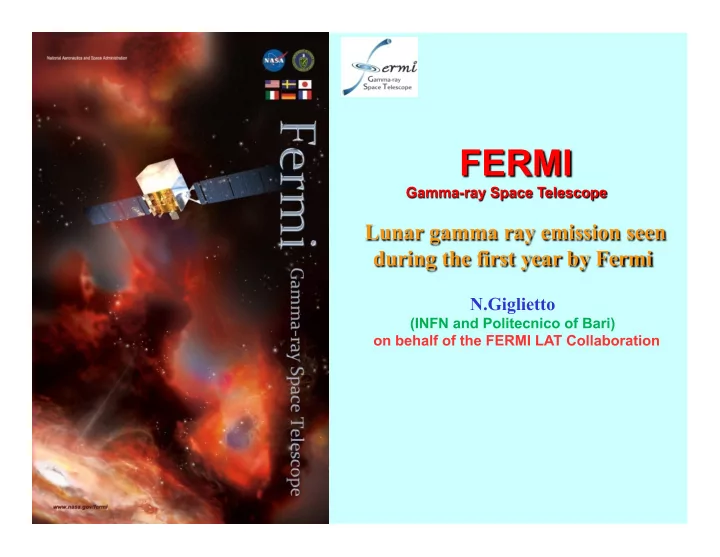

Sources in Solar System Sources: • The Moon • The Sun (quiet and/or flaring) • The Earth Potential Sources Asteroids in different populations: Main Asteroid Belt (MBAs) Jovian and Neptunian Trojans (Trojans) Kuiper Belt Objects (KBOs) Other planets Debris (< few meter size, dust, grains) MBAs, Trojans, KBOs Oort Cloud 2 2 N.Giglietto – Fermi Symposium 2009
Solar system objects observation interest Moon gamma ray emission depends on the flux of • CR nuclei near its surface Quiet solar gamma ray emission has two • components: IC due to the CR electron scattering off solar photons in the heliosphere and the CR nuclei interactions with the solar atmosphere Therefore the gamma ray emission studies are a • sensible probe for CR fluxes in the solar system Gamma ray flux measurements during the entire • solar cycle will be very important! 3 N.Giglietto – Fermi Symposium 2009
Emission mechanism “ γ -ray albedo” due to CR interactions with surface material: Moon rock (solid) Solar atmosphere (gaseous) Lunar γ -ray emission: CR γ γ -rays produced by π 0 decays produced in hadronic showers we expect lunar limb brighter then central disk γ -ray spectrum should be soft Similar emission mechanism for any solid object in solar system 4 4 N.Giglietto – Fermi Symposium 2009
Data selection Data from Aug 2, 2008 until March 1, 2009 Analysis in celestial relative coordinates (Moon and Sun centered data) SUN is moving about 1°/day MOON is moving about 15°/day E > 100MeV Zenith angle < 105° (to avoid the Earth limb) Galactic Plane Cut (>30°) Moon-Sun angular separation >20° ROI: 10° True/Fake source comparison 5 5 N.Giglietto – Fermi Symposium 2009
Background estimation approach The “fake” source method: A fake source follow the path of the real source (on the ecliptic) but 30 degrees away (passes through the same areas on the sky but at different times) fake moon (30° from true moon) True moon position 6 6 Example of monthly lunar path (along the ecliptic) in galactic coordinates N.Giglietto – Fermi Symposium 2009
The Moon: first 7 months Moon count map and projections in RA and DEC axes centered on Moon position. E>100MeV 0.2deg/bin gaussian smothed 7 N.Giglietto – Fermi Symposium 2009
Moon Spectra FERMI-LAT data limb (outer 5’) center (inner 20”) Moskalenko Pion decay of the Moon disk &Porter’07 8 8 N.Giglietto – Fermi Symposium 2009
Sun and Moon spectra: a comparison Moon and Sun Spectra Compared 9 9 N.Giglietto – Fermi Symposium 2009
CR Fluxes comparison (from EGRET era to now) LAT EGRET Actual CR fluxes are ~ 10% higher than EGRET era 10 N.Giglietto – Fermi Symposium 2009
Most of jupiter trojans are along this line Search for emission from other objects in the solar system: • Jupiter trojans and asteroids are potentially emitting gamma-rays • Many of these objects lie along the ecliptic plane • Any pointlike or extended emission along the ecliptic plane is carefully checked • No evidence of Photon count map during the first 10 months centered on emission till now Jupiter position (marked by a circle). The colored vertical • The galatic plane scale is linear and a smoothing has been applied to the image. emission clearly visible The bin width used is 0.2°. The coordinates are celestial on side coordinate offsets respect to Jupiter position, the axes drawn represent the ecliptic coordinates. 11 11
Conclusions During the first months of data taking Fermi has observed the quiet Sun and the Moon emission Preliminary Spectra and Fluxes has been reported for both sources The Fermi preliminary results are consistent with predictions at solar minimum activity Search for gamma-ray emission from any other solar system object in progress 12 12 N.Giglietto – Fermi Symposium 2009
Recommend
More recommend